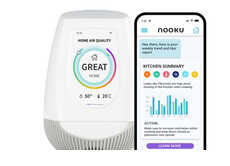
This Sensor Can be Mounted on Street Lamps
Michael Hemsworth — June 14, 2019 — Eco
References: chalmers.se & newatlas
The World Health Organization (WHO) estimates that seven million premature deaths occur around the world because of air pollution, which is prompting new devices like this urban air pollution sensor to be developed.
The sensor has been created by researchers at the Chalmers University of Technology and is designed to be discreetly mounted onto existing street lamps in urban areas. The device consists of an optical nano-sensor that measures for low concentrations of nitrogen dioxide in the surrounding area. This data could then be used to pinpoint areas of high risk that require infrastructure changes or municipal attention to curb pollution.
Researcher Irem Tanyeli explained the urban air pollution sensor saying, "Air pollution is a global health problem. To be able to contribute to increased knowledge and a better environment feels great. With the help of these small, portable sensors, it can become both simpler and cheaper to measure dangerous emissions extremely accurately."
Image Credit: Mia Halleröd Palmgren/Chalmers University of Technology
The sensor has been created by researchers at the Chalmers University of Technology and is designed to be discreetly mounted onto existing street lamps in urban areas. The device consists of an optical nano-sensor that measures for low concentrations of nitrogen dioxide in the surrounding area. This data could then be used to pinpoint areas of high risk that require infrastructure changes or municipal attention to curb pollution.
Researcher Irem Tanyeli explained the urban air pollution sensor saying, "Air pollution is a global health problem. To be able to contribute to increased knowledge and a better environment feels great. With the help of these small, portable sensors, it can become both simpler and cheaper to measure dangerous emissions extremely accurately."
Image Credit: Mia Halleröd Palmgren/Chalmers University of Technology
Trend Themes
1. Discreet Urban Air Pollution Sensors - Developing sensors that can be discreetly mounted onto existing infrastructure in urban areas allows for accurate and widespread monitoring of air pollution.
2. Optical Nano-sensors for Air Quality - Advancements in optical nano-sensors enable precise measurements of low concentrations of nitrogen dioxide, contributing to improved air quality monitoring.
3. Data-driven Pollution Mitigation Strategies - Utilizing data collected from urban air pollution sensors helps in identifying high-risk areas and enables the implementation of targeted infrastructure changes and pollution-reduction efforts.
Industry Implications
1. Smart City Infrastructure - Incorporating air pollution sensors into existing street lamps provides opportunities for companies in the smart city infrastructure sector to offer innovative solutions for urban air quality management.
2. Environmental Monitoring - The development of discreet urban air pollution sensors creates avenues for companies specializing in environmental monitoring to enhance their product offerings and broaden their market reach.
3. Public Health and Safety - Implementing urban air pollution sensors can benefit the public health and safety sector by providing valuable data to inform policy decisions and initiatives focused on reducing air pollution-related health risks.
4.6
Score
Popularity
Activity
Freshness























